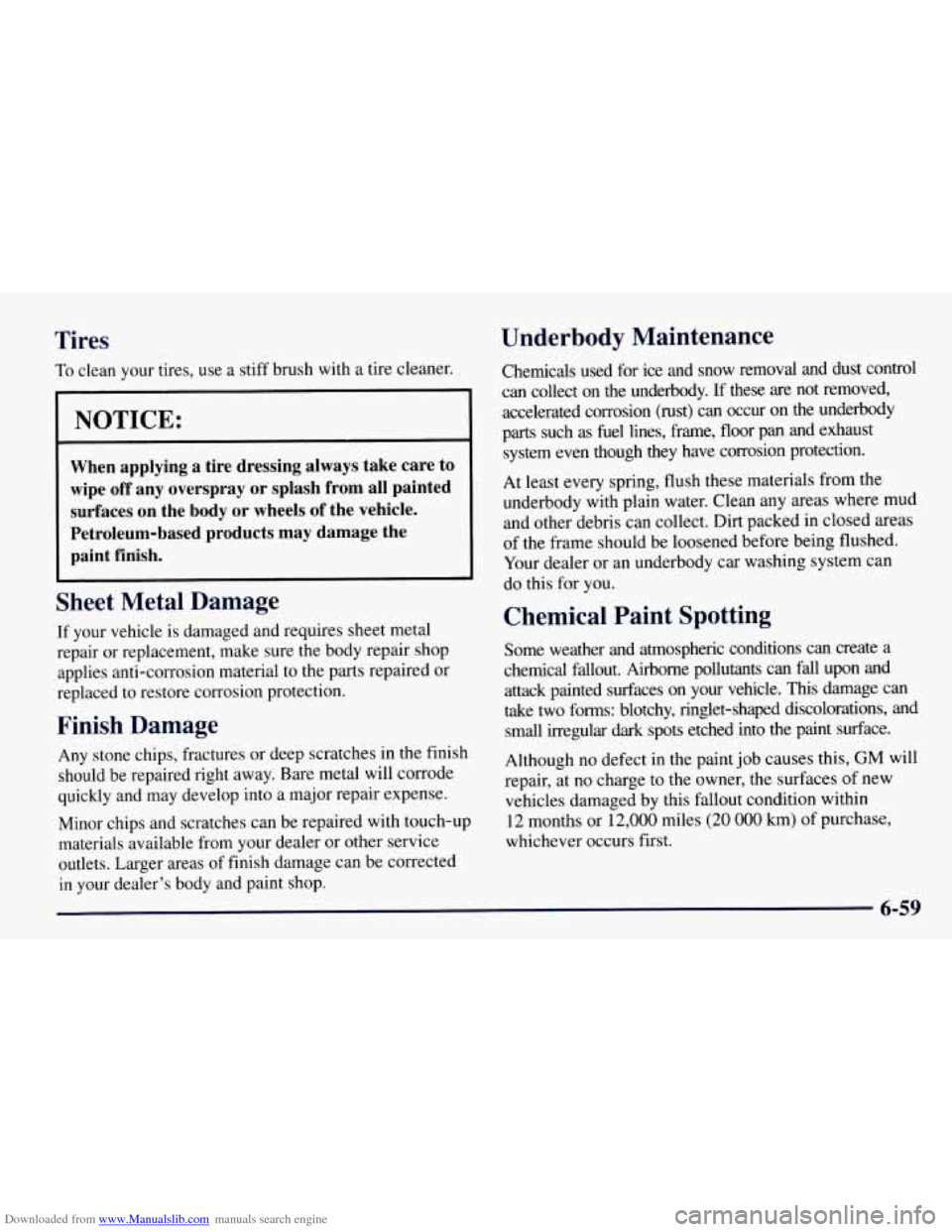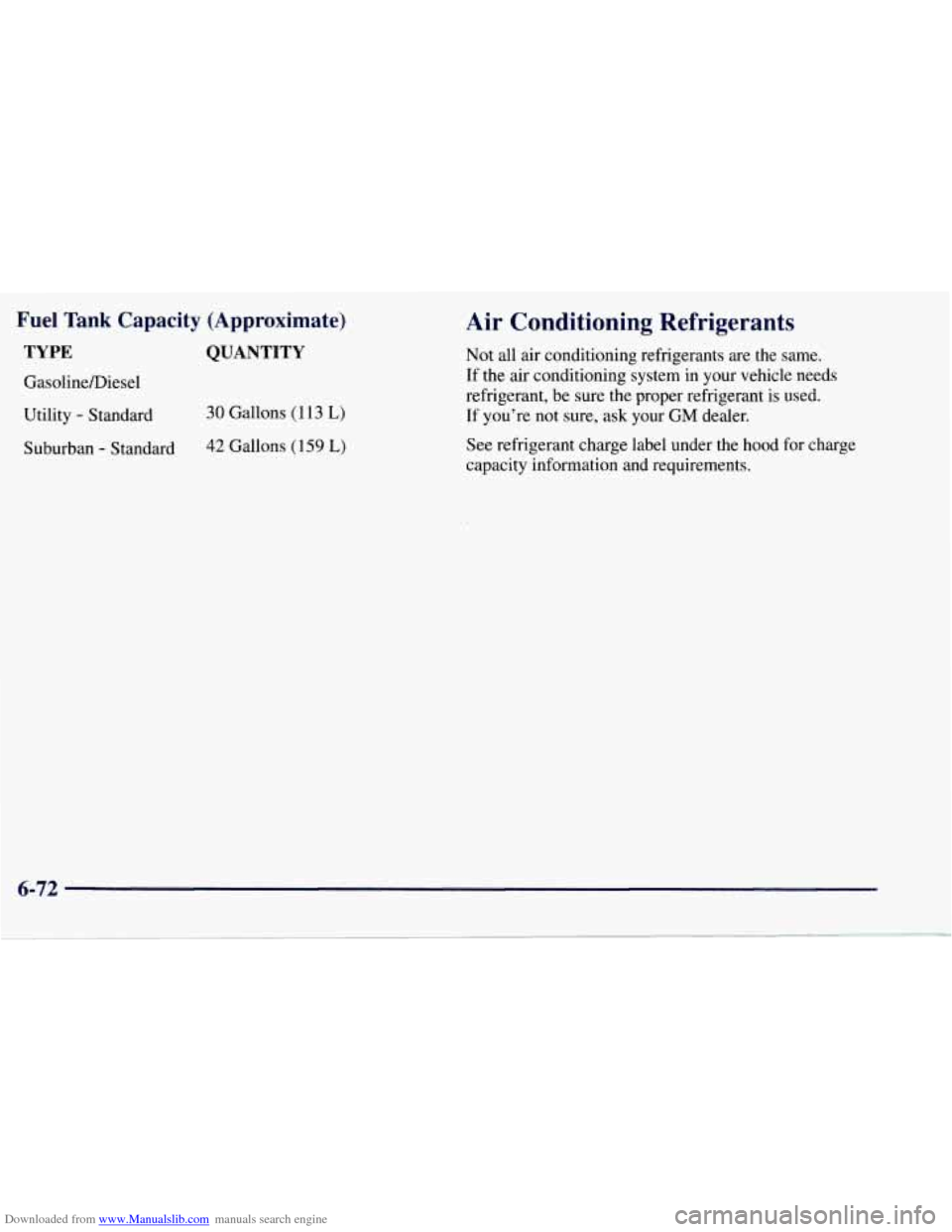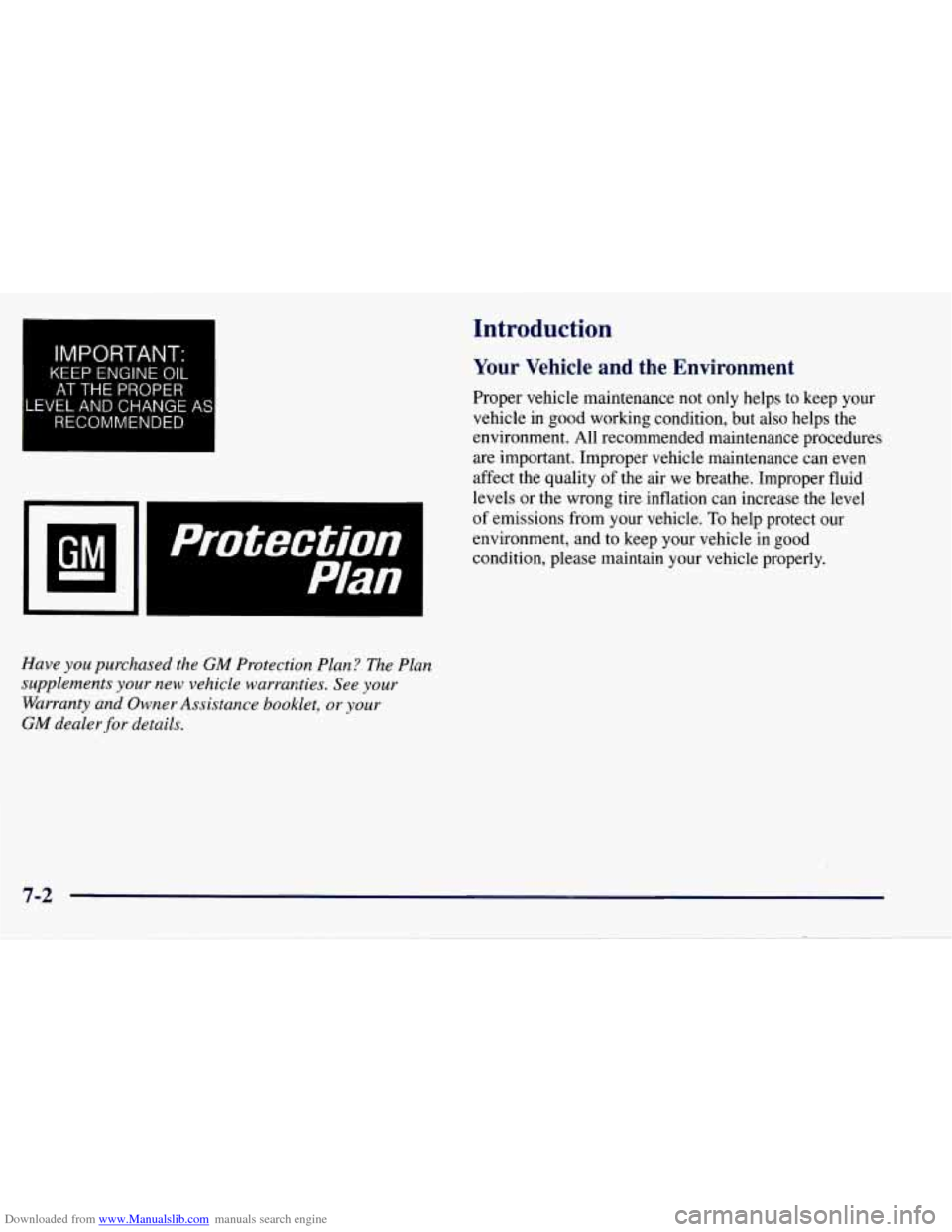1997 CHEVROLET TAHOE air condition
[x] Cancel search: air conditionPage 315 of 433

Downloaded from www.Manualslib.com manuals search engine Fluid Leak Check
After the vehicle has been parked for a while, inspect
the surface under the vehicle for water, oil, fuel or other
fluids. Water dripping from the air conditioning system
after
it has been used is normal. If you notice fuel leaks
or fumes, the causes should be found and corrected
at once.
Battery
Every new vehicle has a Delco Freedom@ battery. You
never have to add water to one of these. When it’s time
for a new battery, we recommend a Delco Freedom
battery. Get one that has the replacement number shown
on the original battery’s label.
Vehicle Storage
If you’re not going to drive your vehicle for 25 days
or more, take off the black, negative
(-) cable from
the battery. This will help keep your battery from
running down.
/d CAUTION:
Batteries have acid that can burn you and gas
that can explode. You can be badly hurt if
you
aren’t careful. See “Jump Starting” in the Index
for tips on working around a battery without
getting hurt.
Contact your dealer to learn how to prepare your vehicle
for longer storage periods.
Also, for your audio system, see “Theft-Deterrent
Feature” in the Index.
6-36
Page 329 of 433

Downloaded from www.Manualslib.com manuals search engine Temperature -- A, B, C
The temperature grades are A (the highest), B, and C,
representing the tire’s resistance to the generation of
heat and its ability to dissipate heat when tested under
controlled conditions on a specified indoor laboratory
test wheel. Sustained high temperature can cause the
material
of the tire to degenerate and reduce tire life, and
excessive temperature can lead
to sudden tire failure.
The grade
C corresponds to a level of performance
which all passenger car tires must meet under the
Federal Motor Vehicle Safety Standard
No. 109. Grades
B and A represent higher levels of performance on the
laboratory test wheel than the minimum required by law.
Warning: The temperature grade for this tire
is
established for a tire that is properly inflated and not
overloaded. Excessive speed, underinflation, or
excessive loading, either separately or in combination,
can cause heat buildup and possible tire failure.
Wheel Alignment and Tire Balance
The wheels on your vehicle were aligned and balanced
carefully at the factory to give you the longest tire life
and best overall performance. Scheduled wheel alignment and
wheel balancing are not
needed. However,
if you notice unusual tire wear or
your vehicle pulling one way or the other,
the alignment
may need to
be reset. If you notice your vehicle
vibrating when driving on a smooth road, your wheels
may need to be rebalanced.
Wheel Replacement
Replace any wheel that is bent, cracked, or badly rusted
or corroded. If wheel nuts keep coming loose, the wheel,
wheel bolts and wheel
nuts should be replaced. If the
wheel leaks air, replace it (except some aluminum
wheels, which can sometimes be repaired). See your
GM dealer if any of these conditions exist.
Your dealer will know the kind of wheel you need.
Each new wheel should have the same load-carrying
capacity, diameter, width, offset and be mounted the
same way as the one it replaces.
If you need to replace any of your wheels, wheel bolts
or wheel nuts, replace them only with new
GM original
equipment parts. This way, you will be sure to have the
right wheel, wheel bolts and wheel nuts for your vehicle.
6-50
Page 338 of 433

Downloaded from www.Manualslib.com manuals search engine Tires
To clean your tires, use a stiff brush with a tire cleaner.
L
NOTICE:
When applying a tire dressing always take care to
wipe off any overspray or splash from all painted
surfaces on the body or wheels of the vehicle.
Petroleum-based products may damage the paint fidish.
Sheet Metal Damage
If your vehicle is damaged and requires sheet metal
repair or replacement, make sure the body repair shop
applies anti-corrosion material to the parts repaired or
replaced to restore corrosion protection.
Finish Damage
Any stone chips, fractures or deep scratches in the finish
should be repaired right away. Bare metal will corrode
quickly and may develop into a major repair expense.
Minor chips and scratches can be repaired with touch-up
materials available from your dealer
or other service
outlets. Larger areas of finish damage can be corrected
in your dealer’s body and paint shop.
Underbody Maintenance
Chemicals used for ice and snow removal and dust control
can collect
on the underbody. If these are not removed,
accelerated corrosion (rust) can occur on the underbody
parts such as fuel lines, frame, floor pan and exhaust
system even though they have corrosion protection.
At least every spring, flush these materials from the
underbody with plain water. Clean any areas where mud
and other debris can collect. Dirt packed in closed areas
of the frame should be loosened before being flushed.
Your dealer or an underbody car washing system can
do this for you.
Chemical Paint Spotting
Some weather and atmospheric conditions can create a
chemical fallout. Airborne pollutants can fall upon and
attack painted surfaces on your vehicle.
This damage can
take two
forms: blotchy, ringlet-shaped discolorations, and
small irregular dark spots etched into the paint surface.
Although
no defect in the paint job causes this, GM will
repair, at no charge to the owner, the surfaces of new
vehicles damaged
by this fallout condition within
12 months or 12,000 miles (20 000 km) of purchase,
whichever occurs first.
6-59
Page 345 of 433

Downloaded from www.Manualslib.com manuals search engine Name
ECM-B
RR DEFOG
IGN-E
Circuits Protected
Fuel Pump, PCMNCM
Rear Window Defogger
Auxiliary Fan Relay Coil,
A/C Compressor Relay,
Hot Fuel Module
Name
FUEL SOL
GLOW PLUG
HORN
AUX FAN
ECM-
1
AIC ENG-
1
LIGHTING
BATT
IGN-A IGN-B
ABS
BLOWER
STOP/HAZ
Circuits Protected
Fuel Solenoid (Diesel Engine)
Glow plugs (Diesel Engine)
Horn, Underhood Lamps
Auxiliary Fan
Injectors, PCMNCM
Air Conditioning
Ignition Switch, EGR, Canister
Purge, EVRV Idle Coast Solenoid,
Heated
02, Fuel Heater
(Diesel Engine), Water Sensor
(Diesel Engine)
Headlamp and Panel Dimmer
Switch, Fog and Courtesy Fuses
Battery, Fuse Block Busbar
Ignition Switch
Ignition Switch Anti-Lock Brake Module
Hi Blower and Rear
Blower Relays
Stoplamps
6-66
Page 351 of 433

Downloaded from www.Manualslib.com manuals search engine Fuel Tank Capacity (Approximate)
TYPE QUANTITY
GasolineDiesel
Utility
- Standard
Suburban
- Standard
30 Gallons (1 13 L)
42 Gallons (159 L)
Air Conditioning Refrigerants
Not all air conditioning refrigerants are the same.
If the air conditioning system in your vehicle needs
refrigerant, be sure the proper refrigerant is used.
If you’re not sure, ask your GM dealer.
See refrigerant charge label under the hood for charge
capacity information and requirements.
6-72
Page 355 of 433

Downloaded from www.Manualslib.com manuals search engine IMPORTANT:
KEEP ENGINE OIL
AT THE PROPER
LEVEL AND CHANGE AS
RECOMMENDED
1.
Protection
Plan
Have you purchased the GM Protection Plan? The Plan
supplements
your new vehicle warranties. See your
Warranty and Owner Assistance booklet, or your
GM dealer for details.
Introduction
Your Vehicle and the Environment
Proper vehicle maintenance not only helps to keep your
vehicle in
good working condition, but also helps the
environment. All recommended maintenance procedures
are important. Improper vehicle maintenance can even
affect the quality
of the air we breathe. Improper fluid
levels or the wrong tire inflation can increase the level
of emissions from your vehicle.
To help protect our
environment, and to keep your vehicle in good
condition, please maintain your vehicle properly.
Page 356 of 433

Downloaded from www.Manualslib.com manuals search engine How This Section is Organized
The remainder of this section is divided into five parts:
“Part
A: Scheduled Maintenance Services” shows
what
to have done and how often. Some of these
services can be complex,
so unless you are technically
qualified and have the necessary equipment, you should
let your dealer’s service department or another qualified
service center do these jobs.
Performing maintenance work on
a vehicle can
be dangerous. In trying to do some jobs, you can
be seriously injured.
Do your own maintenance
work only if you have the required know-how
and the proper tools and equipment for the job.
If you have any doubt, have a qualified
technician do the work.
If you are skilled enough to do some work on your
vehicle, you will probably want to get the service
information GM publishes. See “Service and Owner
Publications” in the Index. “Part
B: Owner Checks and Services”
tells you what
should be checked and when. It
also explains what you
can easily do to help keep your vehicle
in good condition.
“Part
C: Periodic Maintenance Inspections” explains
important inspections that your GM dealer’s service
department or another qualified service center
should perform.
“Part
D: Recommended Fluids and Lubricants” lists
some products GM recommends to help keep your
vehicle properly maintained. These products, or their
equivalents, should be used whether you do the work
yourself or have it done.
“Part E: Maintenance Record” provides a place
for you to record the maintenance performed on your
vehicle. Whenever any maintenance
is performed, be
sure to write it down in this part. This will help you
determine when your next maintenance should be done.
In addition, it
is a good idea to keep your maintenance
receipts. They may be needed to qualify your vehicle for
warranty repairs.
7-3
Page 357 of 433

Downloaded from www.Manualslib.com manuals search engine Part A: Scheduled Maintenance
Services
Using Your Maintenance Schedule
We at General Motors want to help you keep your vehicle
in good working condition. But we don’t know exactly
how you’ll drive it. You may drive very short distances
only a few times a week. Or
you may drive long distances
all the time
in very hot, dusty weather. You may use your
vehicle
in making deliveries. Or you may drive it to work,
to do errands or in many other ways.
Because of all the different ways people use their GM
vehicles, maintenance needs vary. You may even need
more frequent checks and replacements than you’ll find
in the schedules in this section.
So please read this
section and note how you drive.
If you have any
questions on how to keep your vehicle in good
condition,
see your GM dealer.
This part tells you the maintenance services you should
have done and when you should schedule them. If you
go
to your dealer for your service needs, you’ll know
that GM-trained and supported service people will
perform the work using genuine GM parts.
The proper fluids and lubricants to use are listed in Part D.
Make sure whoever services your vehicle uses these. All parts should be replaced and all necessary repairs done
before you
or anyone else drives the vehicle.
These schedules are for vehicles that:
0
0
0
0
carry passengers and cargo within recommended
limits. You will find these limits on your vehicle’s
Certificatioflire label. See “Loading Your Vehicle”
in the Index.
are driven on reasonable road surfaces within legal
driving limits.
are driven off-road in the recommended manner. See
“Off-Road Driving With Your Four- Wheel-Drive
Vehicle” in the Index.
use the recommended fuel. See “Fuel” in the Index.
Selecting the Right Schedule
First you’ll need to decide which of the two schedules is
right for your vehicle. Here’s how to decide which
schedule
to follow:
Gasoline engine vehicles and diesel engine vehicles
have different maintenance requirements. If you have a
diesel engine, follow a schedule designated for diesel
engine vehicles only.
See the Diesel Engine Supplement for diesel engine
maintenance schedules.
7-4